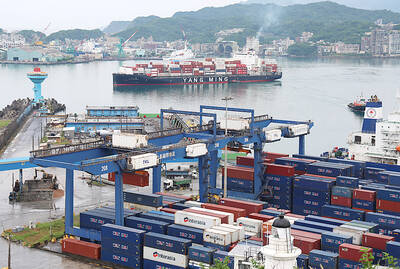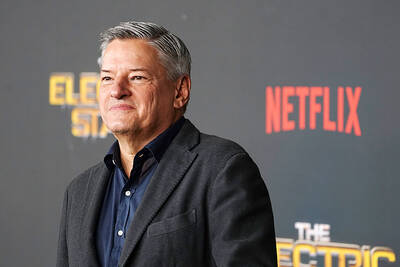Taiwanese companies have steadily built up their intellectual property (IP) portfolios over the past decade — including through a steady rise in research and development (R&D), which hit a record last year, government figures showed on Monday.
R&D spending last year rose to NT$793.7 billion (US$27.59 billion), up from NT$439.7 billion in 2011, Directorate-General of Budget, Accounting and Statistics (DGBAS) data showed.
Last year’s figure was up 2.6 percent from a year earlier after adjusting for inflation, the DGBAS said.
A trade dispute between the US and China has prompted many foreign buyers to shift orders away from Chinese companies to Taiwanese suppliers, leading local companies to invest more in fixed assets, including IP development, the agency said.
Last year, fixed-asset investments rose 14.7 percent from a year earlier to NT$5.65 trillion, the first time it has exceeded NT$5 trillion, the DGBAS said.
Fixed-asset investments included NT$1.16 trillion in areas related to IP, or 20.5 percent of the total, a rise of 1.7 percentage points from a year earlier, the agency said.
The increase in R&D spending indicates that many local companies have sensed the importance of improving their intellectual property and reducing their vulnerability to foreign counterparts if investment in the area is lacking, agency officials said.
One example was the US’ ability to impose bans on exports of key technologies to Beijing because US companies own high-end technology patents that give them an edge over Chinese competitors, officials said.
A Ministry of Science and Technology survey also showed incremental growth in R&D spending among Taiwanese companies.
Enterprises in Taiwan spent NT$593.4 billion on R&D in 2020, up 11 percent from a year earlier, the highest rate of growth since 2005, the survey found.
Of that spending, 92.1 percent was in the manufacturing sector, while the service sector accounted for only 7.6 percent, the survey found.
Suppliers of electronic components, and makers of computers and optoelectronics were the two largest R&D spenders, investing NT$324 billion and NT$129.4 billion respectively in 2020, the DGBAS said.
Other major areas of fixed-asset investment last year were NT$2.14 trillion, or 37.9 percent of the total, in construction and NT$2.08 trillion, or 36.8 percent of the total, in machinery and equipment, it said.

Taiwan’s exports soared 56 percent year-on-year to an all-time high of US$64.05 billion last month, propelled by surging global demand for artificial intelligence (AI), high-performance computing and cloud service infrastructure, the Ministry of Finance said yesterday. Department of Statistics Director-General Beatrice Tsai (蔡美娜) called the figure an unexpected upside surprise, citing a wave of technology orders from overseas customers alongside the usual year-end shopping season for technology products. Growth is likely to remain strong this month, she said, projecting a 40 percent to 45 percent expansion on an annual basis. The outperformance could prompt the Directorate-General of Budget, Accounting and

The demise of the coal industry left the US’ Appalachian region in tatters, with lost jobs, spoiled water and countless kilometers of abandoned underground mines. Now entrepreneurs are eyeing the rural region with ambitious visions to rebuild its economy by converting old mines into solar power systems and data centers that could help fuel the increasing power demands of the artificial intelligence (AI) boom. One such project is underway by a non-profit team calling itself Energy DELTA (Discovery, Education, Learning and Technology Accelerator) Lab, which is looking to develop energy sources on about 26,305 hectares of old coal land in

Netflix on Friday faced fierce criticism over its blockbuster deal to acquire Warner Bros Discovery. The streaming giant is already viewed as a pariah in some Hollywood circles, largely due to its reluctance to release content in theaters and its disruption of traditional industry practices. As Netflix emerged as the likely winning bidder for Warner Bros — the studio behind Casablanca, the Harry Potter movies and Friends — Hollywood’s elite launched an aggressive campaign against the acquisition. Titanic director James Cameron called the buyout a “disaster,” while a group of prominent producers are lobbying US Congress to oppose the deal,

Two Chinese chipmakers are attracting strong retail investor demand, buoyed by industry peer Moore Threads Technology Co’s (摩爾線程) stellar debut. The retail portion of MetaX Integrated Circuits (Shanghai) Co’s (上海沐曦) upcoming initial public offering (IPO) was 2,986 times oversubscribed on Friday, according to a filing. Meanwhile, Beijing Onmicro Electronics Co (北京昂瑞微), which makes radio frequency chips, was 2,899 times oversubscribed on Friday, its filing showed. The bids coincided with Moore Threads’ trading debut, which surged 425 percent on Friday after raising 8 billion yuan (US$1.13 billion) on bets that the company could emerge as a viable local competitor to Nvidia